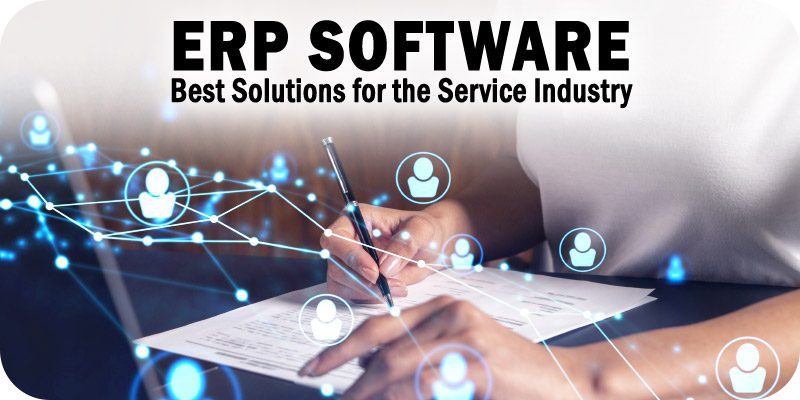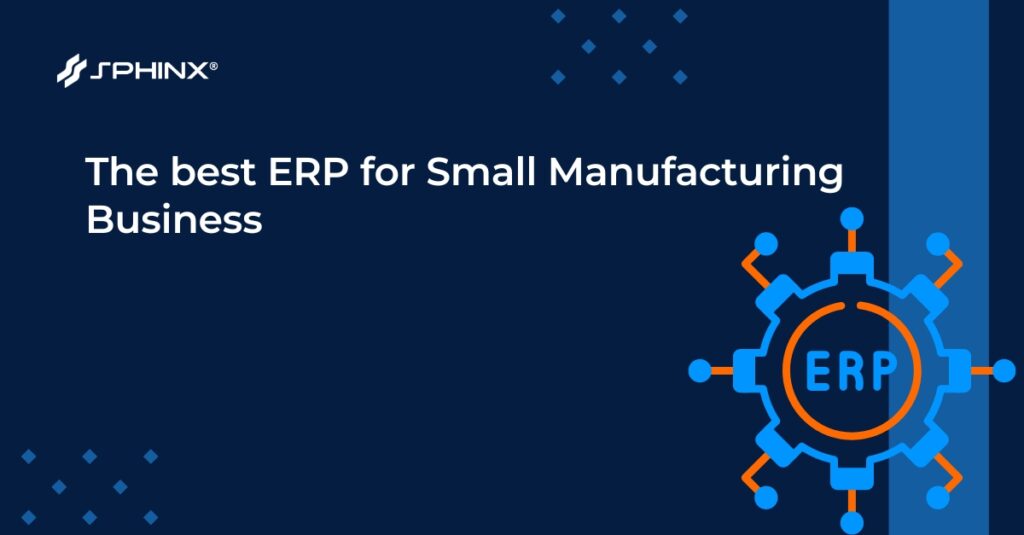Are you considering whether it’s the right moment to leverage Enterprise Resource Planning (ERP) software to elevate your small manufacturing business? Besides, perhaps you already recognize the need for an ERP solution but are uncertain about which software fits your budget while supporting your business growth. Let’s explore with Sphinx about the leading ERP systems for small manufacturing businesses in 2024.
1. What Is an ERP System in Manufacturing?
An ERP system for manufacturing is an all-encompassing tool designed to fulfill the diverse needs of manufacturing firms. It unifies multiple business processes, including production planning, inventory control, supply chain management, finance, human resources, and customer relationship management within one platform. By offering real-time visibility and data-driven insights, ERP software enables manufacturers to make well-informed decisions, streamline operations, and boost overall efficiency.
Here are the main features that an ERP (Enterprise Resource Planning) system for manufacturing businesses needs:
1.1. Inventory Management
Monitoring the status of raw materials, ongoing production, and completed products in real-time. This includes managing stock levels, order processing, and warehouse management.
1.2. Production Planning and Scheduling
Tools for planning production schedules, managing work orders, and optimizing manufacturing processes to ensure timely delivery and efficient use of resources.
1.3. Supply Chain Management
Integration with suppliers and logistics providers to streamline procurement, manage supplier relationships, and optimize the supply chain network.
1.4. Quality Control
Systems to monitor and manage product quality at various stages of production, ensuring compliance with standards and reducing defects.
1.5. Financial Management
Comprehensive financial modules that include accounting, budgeting, forecasting, and financial reporting to ensure accurate financial tracking and planning.
2. Roles of An ERP System in Manufacturing
Here are the main roles that an ERP (Enterprise Resource Planning) system for manufacturing businesses:
2.1. Real-time Insights and Decision-Making
One of the main advantages of integrating an ERP system into a manufacturing firm is obtaining real-time insights. This immediate access to precise and current information enables managers to make well-informed decisions swiftly. By examining data related to production processes, inventory statuses, customer demand, and financial results, manufacturers can pinpoint inefficiencies, enhance resource distribution, and synchronize their strategies with market developments.
2.2. Increase Productivity and Data Integration
ERP systems strive to integrate various aspects of a manufacturing company’s operations into a unified platform. This software enhances supply chain management, production planning, inventory control, and quality assurance, facilitating smooth interdepartmental collaboration. By automating workflows and reducing manual tasks, manufacturers can significantly boost productivity, cut costs, and eradicate data silos.
2.3. Scalability and Flexibility
As companies expand, their operational demands also change. ERP systems provide the scalability and adaptability needed to meet these shifting organizational needs. Whether you’re entering new markets, broadening your range of products, or overseeing multiple locations, a strong ERP system can handle these complexities. Manufacturers can effortlessly scale their operations by offering a comprehensive view of the entire business while ensuring consistent processes and control.
3. The best ERP Software Solutions for Manufacturing
Let’s take a look at some of the best manufacturing ERP software solutions currently available.

The best ERP Software Solutions for Manufacturing
3.1. SAP S/4HANA
SAP S/4HANA is an all-encompassing ERP system tailored for the manufacturing sector. It provides seamless integration across procurement, production, sales, and service operations. Leveraging advanced analytics and real-time data processing, manufacturers can make informed decisions to boost efficiency and improve customer satisfaction.
SAP S/4HANA incorporates advanced technologies such as artificial intelligence (AI) and machine learning (ML), facilitating predictive analytics and automation. While SAP offers a comprehensive solution, its high cost per user can make it prohibitively expensive for small and medium-sized enterprises (SMEs).
3.2. Microsoft Dynamics 365 Business Central
Microsoft Dynamics 365 Business Central is a customizable ERP solution designed to help manufacturers optimize their processes. It includes sophisticated tools for demand forecasting, production planning, quality assurance, and warehouse management.
Manufacturers can boost their efficiency by using familiar interfaces and smoothly connecting with other Microsoft applications like Excel, Outlook, and Power BI. Business Central’s cloud-based structure offers scalability and can be accessed from any device.
Nonetheless, small and medium-sized enterprises (SMEs) might encounter challenges related to scalability and costs. Although Dynamics 365 Business Central is intended to support business growth, SMEs undergoing swift expansion might find that the system’s capabilities become insufficient over time, necessitating a transition to a more robust ERP solution.
When it comes to expenses, the licensing, implementation, and yearly subscription fees for Dynamics 365 Business Central may be prohibitively expensive for some small and medium-sized enterprises (SMEs). It is important to thoroughly evaluate the total cost of ownership, which also includes training, maintenance, and customizations.
3.3. Oracle NetSuite
Oracle NetSuite is a cloud-based ERP solution designed to meet the specific needs of manufacturing firms. It offers a comprehensive platform for overseeing financial management, supply chains, inventory, and production processes. Featuring powerful reporting and analytics capabilities, it allows manufacturers to obtain detailed insights into their business performance.
Additionally, Oracle NetSuite facilitates collaboration with suppliers, partners, and customers via its integrated portal, promoting transparency and strengthening relationships.
Similar to SAP, Oracle NetSuite can be quite costly, particularly for small and medium-sized enterprises (SMEs) operating with limited budgets. The expenses associated with licensing, implementation, and customization can accumulate rapidly, making it less practical for smaller businesses facing financial limitations. Additionally, the system’s broad range of features and flexibility might pose challenges.
Determine the Key Factors to Choose the Right ERP Solution for Your Business
Your company’s data reveals the core of your business operations. While some of these operations are crucial for maintaining a competitive edge, others might hinder your efficiency and growth.
At Sphinx, we begin by pinpointing the problematic areas in your current processes to enhance efficiency and find the best solutions to achieve your long-term objectives.
When selecting from the numerous ERP options available in the market, it is essential to evaluate their features and benefits to identify the most suitable tool for your business. Although well-known companies such as SAP, Microsoft, and Sage are prominent, it’s important to consider the specific advantages and support each solution offers.
Consulting with ERP experts like Sphinx can assist you in choosing the right ERP system for your organization.




CEO - Son Le
기타 블로그
블로그
Transform Your Business with SAP Consulting Support
In today’s digital-first landscape, enterprise systems must evolve continuously to keep up with rising customer expectations, data complexity, and the demand for operational excellence. SAP plays a central role in this transformation, offering intelligent, integrated solutions that help organizations modernize their operations and drive long-term growth. However, SAP only delivers...
자세히 보기블로그
Agentic AI vs. Generative AI: What You Need to Know
Artificial Intelligence is reshaping how organizations create, analyze, and deliver value. Among the most transformative innovations are Generative AI and Agentic AI, two models that share similar foundations but serve distinct purposes. Generative AI focuses on producing new content like text, images, or code based on user input. In this...
자세히 보기블로그
Cloud vs On-Premise: Which Deployment Model Fits Your Business?
Choosing between cloud and on-premise systems has become one of the most important technology decisions for modern businesses. As digital transformation accelerates, every company must decide whether to keep its data and applications on internal servers or move them to cloud platforms managed by external providers. The choice affects everything...
자세히 보기기타 블로그
서비스
IoT 개발
SphinX는 최첨단 IoT 개발 서비스를 제공하여 디바이스를 원활하게 연결하고 혁신적인 솔루션을 제공합니다.
테마서비스
블록체인 개발
우리는 신뢰할 수 있고 안전한 블록체인 기술을 처음부터 설계하는 데 매우 능숙하며, ...
테마서비스
ERP 및 CRM 개발
필요한 ERP & CRM 개발 서비스! 비즈니스 프로세스 간소화 및 조직 효율성 향상....
테마기타 블로그
서비스
IoT 개발
SphinX는 최첨단 IoT 개발 서비스를 제공하여 디바이스를 원활하게 연결하고 혁신적인 솔루션을 제공합니다.
테마서비스
블록체인 개발
우리는 신뢰할 수 있고 안전한 블록체인 기술을 처음부터 설계하는 데 매우 능숙하며, ...
테마서비스
ERP 및 CRM 개발
필요한 ERP & CRM 개발 서비스! 비즈니스 프로세스 간소화 및 조직 효율성 향상....
테마